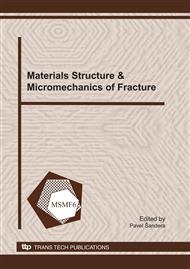[1]
W. S. Slaughter (2001), The Linearized Theory of Elasticity, Section 9. 4, Birkhausen, Boston.
Google Scholar
[2]
C. J. Christopher, M. N. James, E. A. Patterson and K. F. Tee, Towards a new model of crack tip stress fields, Int. J. Fract. Vol. 148, (2007), pp.361-371.
DOI: 10.1007/s10704-008-9209-3
Google Scholar
[3]
C. J. Christopher, M. N. James, E. A. Patterson and K. F. Tee, A quantitative evaluation of fatigue crack shielding forces using photoelasticity, Engng Fract. Mech. Vol. 75, (2008), pp.4190-4199.
DOI: 10.1016/j.engfracmech.2008.03.013
Google Scholar
[4]
S. Roychowdhury and R. H. Dodds, Effect of T-stress on fatigue crack closure in 3-D small-scale yielding, Int. J. Solids Structs Vol. 41, (2004), p.2581–2606.
DOI: 10.1016/j.ijsolstr.2003.11.004
Google Scholar
[5]
Y. Kim, X. K. Zhu and Y. J. Chao, Quantification of constraint on elastic–plastic 3D crack front by the J-A2 three-term solution, Engng Fract. Mech. Vol. 68, (2001), p.895–914.
DOI: 10.1016/s0013-7944(00)00134-x
Google Scholar
[6]
M. N. James, C. J. Christopher, Yanwei Lu and E. A. Patterson, Full-field modelling of crack tip shielding via the plastic inclusion, concept, Proc. 2nd Int. Conf. on Advances in Product Development and Reliability, Shenyang, China, 28-30 July, 2010. Advd Mats Res. Vols. 118-120, (2010).
DOI: 10.4028/www.scientific.net/amr.118-120.1
Google Scholar
[7]
P. C. Paris, R. E. Gomez and W. E. Anderson, A rational analytic theory of fatigue, The Trend in Engineering Vol. 13 No. 1, (1961), pp.9-14, University of Washington.
Google Scholar
[8]
R. H. Christensen: Fatigue crack growth affected by metal fragments wedged between opening-closing crack surfaces, Appl. Mater. Res. Vol. 2 No. 4, October 1963, pp.207-210.
Google Scholar
[9]
W. Elber, Fatigue crack closure under cyclic tension, Engng Fract. Mech. Vol. 2, (1970), pp.37-45.
Google Scholar
[10]
M. N. James (1997).
Google Scholar
[11]
L. -W. Wei and M.N. James, A study of fatigue crack closure in polycarbonate CT specimens, Engng Fract. Mech. Vol. 66 No. 2, (2000), pp.223-242.
DOI: 10.1016/s0013-7944(00)00014-x
Google Scholar
[12]
A. S. Patki and E.A. Patterson, Thermoelastic stress analysis of fatigue cracks subject to overloads, Fatigue and Fracture of Engineering Materials and Structures, in press (2010).
DOI: 10.1111/j.1460-2695.2010.01471.x
Google Scholar
[13]
M. L. Williams, On the stress distribution at the base of a stationary crack, J. Appl. Mech. Vol. 24, (1957), p.109–114.
Google Scholar
[14]
A. H. Sherry, C. C. France and M. R. Goldthorpe, Compendium of T-stress solutions for two and three dimensional cracked geometries, Fatigue Fract. Engng Mater. Struct., Vol. 18 No. 1, (1995), pp.141-155.
DOI: 10.1111/j.1460-2695.1995.tb00148.x
Google Scholar
[15]
K. Ramesh, S. Gupta and A. A. Kelkar, Evaluation of stress field parameters in fracture mechanics by photoelasticity-revisited, Engng Fract. Mech. Vol. 56 No. 1, (1997), pp.25-45.
DOI: 10.1016/s0013-7944(96)00098-7
Google Scholar
[16]
F. Berto and P. Lazzarin, On higher order terms in the crack tip stress field, Letters in Fracture and Micromechanics, Vol. 161, (2010), pp.221-226.
DOI: 10.1007/s10704-010-9443-3
Google Scholar
[17]
H. L. Ewalds and R. J. H. Wanhill, Fracture mechanics, (1984) Edward Arnold, New York, p.97.
Google Scholar
[18]
E. A. Patterson and Z. F. Wang, Towards full-field automated photoelastic analysis of complex components, Strain Vol. 27 No. 2, (1991), p.49–56.
DOI: 10.1111/j.1475-1305.1991.tb00752.x
Google Scholar
[19]
J.R. Yates, M. Zanganeh, Y.H. Tai, Quantifying crack tip displacement fields with DIC, Engng Fract. Mech. (2010), in press.
DOI: 10.1016/j.engfracmech.2010.03.025
Google Scholar
[20]
J. Carroll, C. Efstathiou, J. Lambros, H. Sehitoglu, B. Hauber, S. Spottswood, R. Chona, Investigation of fatigue crack closure using multiscale image correlation experiments, Engineering Fracture Mechanics Vol. 76, (2009), p.2384–2398.
DOI: 10.1016/j.engfracmech.2009.08.002
Google Scholar


